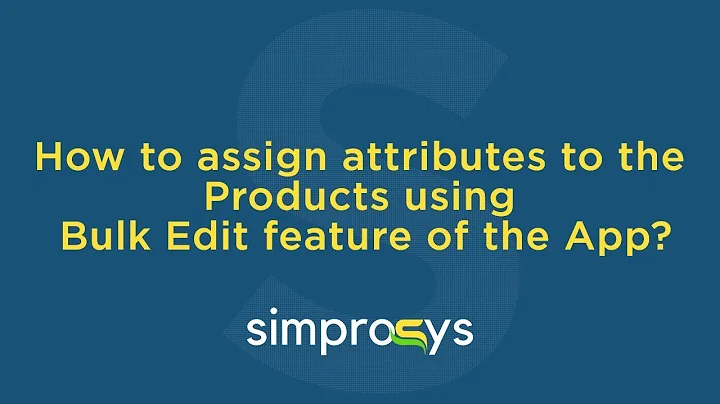Streamline Dropshipping Orders with Zapier
Table of Contents:
- Introduction
- About Shopify Store Orders
- Benefits of Using a CRM Template
- Introduction to Zapier
- Setting Up Google Sheets for Order Management
- Creating a Zap Between Shopify and Google Sheets
- Customizing the Google Sheet for Order Tracking
- Automating Order Management with Zapier
- Adding Supplier Information and Calculating Profit
- Monitoring and Managing Orders
- Conclusion
Introduction
Managing orders for your Shopify store can be both time-consuming and challenging. However, with the right tools and strategies in place, you can streamline this process and ensure smooth order fulfillment. In this article, we will discuss how to effectively manage Shopify store orders using a CRM template and Zapier integration. We will guide you through the step-by-step process of setting up Google Sheets, creating a zap between Shopify and Google Sheets, customizing the Google Sheet for order tracking, automating order management, and monitoring and managing your orders.
About Shopify Store Orders
Shopify store orders are the backbone of your e-commerce business. When a customer places an order on your website, it is essential to efficiently manage and fulfill that order to provide a positive customer experience. Managing orders involves tracking order details, contacting suppliers, processing payments, and ensuring timely delivery to the customers. Without a streamlined system in place, managing store orders can become overwhelming and prone to errors.
Benefits of Using a CRM Template
A Customer Relationship Management (CRM) template can significantly simplify the process of managing Shopify store orders. It provides a structured framework to track and organize order details, supplier information, payment status, and shipping details in one centralized location. With a CRM template, you can easily view and manage all your orders, calculate profit margins, and automate various aspects of order management, saving you time and minimizing errors.
Introduction to Zapier
Zapier is a powerful automation tool that allows you to connect different software applications and automate tasks between them. It enables seamless integration between Shopify and Google Sheets, enabling the automatic transfer of order data from Shopify to a centralized Google Sheet. By utilizing Zapier, you can eliminate manual data entry and ensure accurate and up-to-date order tracking and management.
Setting Up Google Sheets for Order Management
Before integrating Google Sheets with Shopify, you need to set up a Google Sheet specifically for order management. This Google Sheet will serve as your CRM template, where all order details will be stored and organized. To set up the Google Sheet, you can access a pre-made template and make a copy of it in your Google Drive. This will give you complete control over the sheet and allow you to personalize it according to your business requirements.
Creating a Zap Between Shopify and Google Sheets
To establish a connection between Shopify and Google Sheets, Zapier offers a simple and intuitive interface. By creating a "zap," you can define triggers and actions that will automate the process of transferring order data from your Shopify store to the designated Google Sheet. The zap will ensure that whenever a new order is placed, the relevant information is automatically populated in the Google Sheet, eliminating the need for manual data entry.
Customizing the Google Sheet for Order Tracking
Once the zap is in place and order data is successfully transferred to the Google Sheet, you can customize the sheet to display and track essential order details. By assigning columns for order numbers, customer names, email addresses, shipping addresses, order prices, and shipping prices, you can easily identify and manage each order. Additionally, you can use formulas to calculate profit margins and total costs, providing valuable insights into your business's financial performance.
Automating Order Management with Zapier
Automating order management with Zapier allows you to streamline multiple aspects of the process. You can configure the zap to automatically send emails to suppliers, indicating new orders and payment status. This helps ensure efficient communication and timely processing of orders. Furthermore, by integrating other applications, such as Google Drive, you can easily link invoices and track the delivery status of orders, making the entire order management process more efficient and transparent.
Adding Supplier Information and Calculating Profit
To further enhance the functionality of your CRM template, you can add supplier information to the designated columns in the Google Sheet. This includes supplier names, payment status, and invoice numbers. By organizing supplier details, you can easily track payments and maintain an accurate record of transactions. Additionally, by utilizing formulas and functions within the Google Sheet, you can calculate profit margins, gross profit, and total costs, providing valuable insights into your business's profitability.
Monitoring and Managing Orders
Once your CRM template is set up and the automatic order transfer process is in place, you can effectively monitor and manage your orders. The Google Sheet acts as a central dashboard, providing you with a comprehensive overview of all orders, their respective statuses, and financial metrics. You can easily track payments, make updates, and generate reports for analysis or accounting purposes. With this streamlined process, you can ensure efficient order management while maintaining a high level of customer satisfaction.
Conclusion
Effectively managing orders for your Shopify store is crucial for the success of your e-commerce business. By utilizing a CRM template and integrating it with Zapier, you can automate various aspects of order management, resulting in time savings, increased efficiency, and improved accuracy. The combination of Google Sheets and Zapier provides a seamless solution for order tracking, supplier communication, payment processing, and financial analysis. Implementing these strategies will help you streamline your order management process and provide a better overall experience for your customers.
Highlights:
- Streamline Shopify store order management with a CRM template and Zapier integration
- Simplify tracking, organizing, and fulfilling orders in one centralized location
- Automate order data transfer from Shopify to Google Sheets using Zapier
- Customize Google Sheets to track order details, supplier information, and financial metrics
- Enhance order management with automatic supplier communication and invoice tracking
- Monitor and manage orders efficiently using the Google Sheet as a central dashboard
- Improve overall customer satisfaction and business profitability with streamlined processes.
FAQ:
Q: What is a CRM template, and why is it essential for Shopify store order management?
A: A CRM template is a structured framework that helps track and organize order details, supplier information, payment status, and shipping details in one centralized location. It simplifies the process of managing orders, ensuring efficient order tracking and fulfillment.
Q: How does Zapier help in automating order management for Shopify stores?
A: Zapier allows seamless integration between different software applications, such as Shopify and Google Sheets. By creating a "zap," you can define triggers and actions that automate the process of transferring order data from Shopify to Google Sheets, eliminating manual data entry and ensuring accurate order tracking.
Q: Can I customize the Google Sheet for order tracking and financial analysis?
A: Yes, you can customize the Google Sheet according to your business requirements. You can assign columns for order numbers, customer names, email addresses, shipping addresses, order prices, and shipping prices. Additionally, you can use formulas to calculate profit margins and total costs, providing valuable insights into your business's financial performance.
Q: How does automated supplier communication and invoice tracking benefit order management?
A: Automated supplier communication ensures timely processing of orders by notifying suppliers about new orders and payment status. Invoice tracking allows you to link invoices to the Google Sheet, facilitating easy access and record-keeping for accounting and auditing purposes.
Q: How can I monitor and manage orders efficiently using the Google Sheet as a central dashboard?
A: The Google Sheet serves as a central dashboard, displaying all order details, payment status, and financial metrics. By regularly updating the sheet with order information and using filters and sorting, you can easily track payments, make updates, and generate reports for analysis or accounting purposes.






















